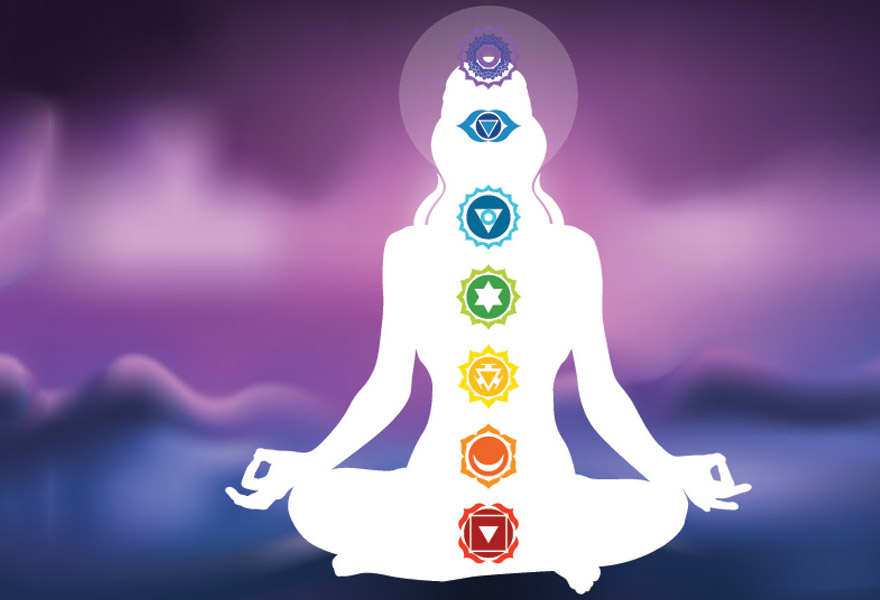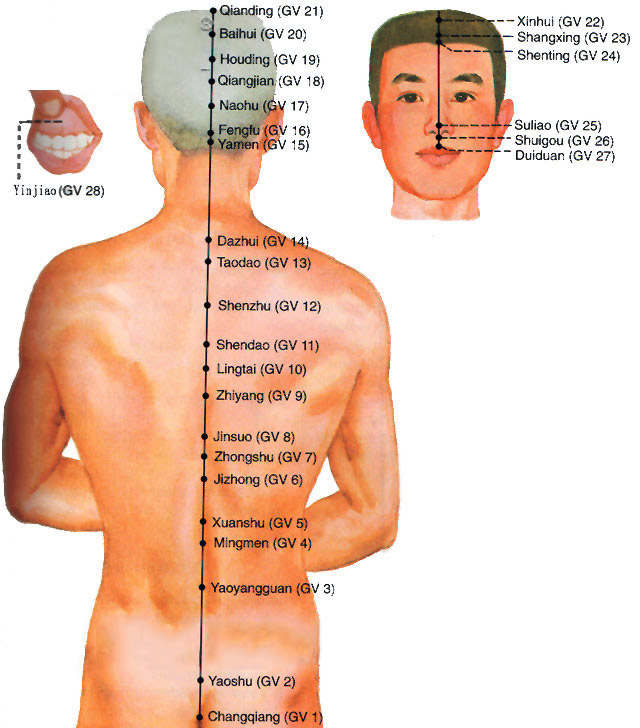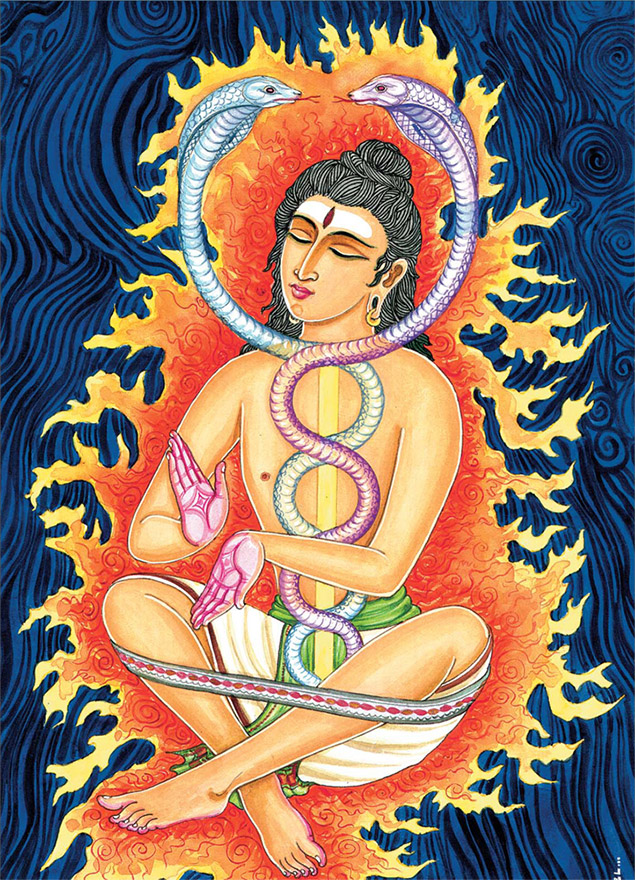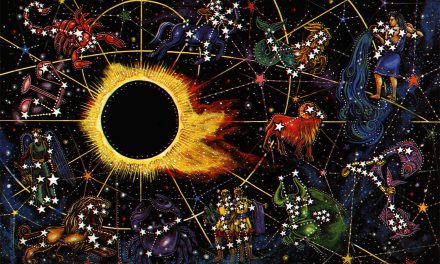“…of the lunar mansions [the twenty-seven nakshatras] I am Abhijit.” – Krishna speaking in Srimad Bhagavatam, Canto 11, ch.16, v.27
I am an amateur astrologer who has been meditating for twenty-five years and studying Maha Yoga under the guidance of Sadguru Sri Vasudeva. I have been researching the nakshatras for a number of years and want to share an amazing discovery that to my knowledge is unknown, namely that the nakshatras relate to points of energy and consciousness along the sushumna subtle channel.
There are twenty-eight points along the Governor Vessel (the Dumai meridian, same as the sushumna nadi) in the acupuncture system of traditional Chinese medicine. These points correspond to the lunar constellations in the Chinese system. Furthermore, in Taoist neidan (inner alchemy) according to Grandmaster Mantak Chia, these points map out how one refines/processes/transmutes life force energy in meditation from gross to subtler forms. I have experienced these refinements myself so I can attest to this.
I am sure it is no coincidence that “nakshatra” sounds similar to “chakra” and “kshetra”. The lunar constellations and stars of the twenty-eight nakshatras come together in a cohesive story (or inner orbit) of minor chakras and nadis dealing with the refinement of the soma/amrita of the Moon/psyche as the soul (jiva) explores the greater possibility of enlightened rapture (ananda). These twenty-eight nakshatras are linked to centers within the brain and cerebrospinal stem through subtle energy channels (nadis/meridians). The Moon represents the mind that rules the astral and causal bodies interpenetrating this gross field of nerve plexuses and vortex points.
[wp_ad_camp_1]
I believe that understanding this alignment of the nakshatras with the sushumna is central to decoding their meaning, and that this represents a lost body of knowledge that is only now coming to light. It must have been part of the older nakshatra system mentioned in the Vedas because in this template Abhijit is included and it begins with Krittika.
Here are some of the more obvious correspondences I have uncovered so far:
Abhijit, the nakshatra Krishna identifies with corresponds to the Brahmarandhra Chakra (GV20), a point at the top of the head, connected to the top of the sushumna nadi, where 100 yang (solar) channels converge. These are the “100 physicians” of Satabhisha.
Purva Ashada is the minor Bindu Chakra at the back of the head where the hair swirls (GV18) and is the posterior position of the Soma chakra. When the yogi is able to bring their sexual energy out of their semen bringing it up to this point, it transmutes into ojas, releasing an intoxicating feeling in the brain.
Purva Bhadrapada is a point (GV24) that is linked to the Manas Chakra in the sushumna, a chakra associated with the naga because it is all about the chitta – all the mental storage in the soul based on sense-impressions and samskaras (attachments).
Jyestha is a point (GV16) corresponding to the posterior of the medulla or Talu chakra, while Bharani (GV28) corresponds to the anterior. As Paramahansa Yogananda states, the (unenlightened) soul enters and exits through the medulla when taking a new birth. Jyestha is located close to the “earring” area and the stem resembles the pole holding up the “umbrella” of the brain. Bharani is associated with the portal between earthly life in Bhur and the afterlife (for the unenlightened soul) in Bhuva.
Krittika (GV1) is located at the coccyx, which has a kind of “spear” or “knife” shape. Located at the beginning of the sushumna at the posterior end of the root chakra, when Kundalini begins to move heat is felt here – hence Krittika’s deity is Agni. Its shakti is the power to burn desires, a theme that is taken up in the mythology sequence related to the next three nakshatras.
Rohini (GV2), Mrigasira (GV3) and Ardra (GV4) are located at the posterior of the sexual and navel chakras. The mythologies associated with their respective deities tell a cohesive story about Brahma lusting after Rohini who is shot down by Rudra’s arrow of restraint. In the context of the refinement of pranic energies in the sushumna, this can be read as an allegory about a yogic practice of bringing the sexual energy into the navel chakra where it is changed back into vitality so that it rejuvenates and strengthens the physical body, giving radiance and health through this center.
This is just a sample of the many things I have discovered. There is more to share and explore but I am now in the process of mapping out the meanings of all these points and am inviting you to contribute to my research. These meanings will be posted on my blog “Chakra Nakshatras” with ongoing updates and more details: chakranakshatras.blogspot.com
You can post comments there or contact me on the site.
I plan to eventually include the Chinese and Mayan astrological meridian systems as well because they also align on this acupuncture map. I am sure an original template must have existed that was known to these three cultures, probably around the start of Kali Yuga. This knowledge goes beyond the Vedic Astrology system, beyond any philosophical or cultural inheritance. My interest is in deciphering the core knowledge that these ancient systems understood and that anyone can access through right meditation and awakened Kundalini.
Author’s Website: chakranakshatras.blogspot.com















It’s important to keep in mind that the acupuncture points on the skin are connected to subtle points in the finer mental bodies and not be limited to the linear representation that appears in gross form.
Thanks alot. Very very good information
Lds Gts
would anyone have a clue on the connection between
fotherapy ( chrometherapy) and accupuncture x chakras?
I´d appreciate any hint, please.
Serrano
really great message you have shared with me
meditation and acupuncture is my most favourable field
Yes as Yvonne says the whole of the acupuncture meridian system is actually a part of an intercommunicating network encompassing the subtle etheric bodies as well as becoming more material at the points that you list.
If you are interested, its worth referencing the practice of Qigong (pronounced Chee gong) as well as the (JingLou) internal and external meridian system which is but a small part of Chinese understanding of the universe. You don’t mention the CV meridian which runs up the front of the body and contains major energy centres that also can be related to the Indian system. There are also many other points that are not on the 14 common meridians which also have a major energy function. However it’s good to see someone find a common thread between the two ancient wisdoms. I guess the layers of life are common which ever country one comes from …… unfortunately many of the illuminating texts are still in Chinese and have not been translated into English. Here are two books which translate the subtle meanings of the points from Chinese to English for you: “Grasping the Wind by Sara Hicks” and ” A comprehensive compendium by Andrew Prescott” Happing reading ….. best wishes Michael acupuncturist – Beijing
Im so loving this have you done uttarbhadra yet? my pisces moon both in vedic and western. the subtle or the more dense points along the meridians all are valuable.imagine if you could meditate on a point clear it clear all your samskaras ground yourself open all spiritual channels even above Brahmandra crown become walking liberation.enlightenment for all sentient beings, i wonder if thenervouse system could handle it.
thank you and thanks Michael in Beijing Michael have you coordinated gigong or any style tai chi with breath on certain points?
Hello Michael Cole,
Thank you for all your comments and links. I am still in the process of putting my research on the net and welcome all who are interested to share on the Facebook group I just started.
I certainly don’t have all the answers but I am sure I am on the right track with this. Different systems will have different philosophies and models for talking about different aspects of the same thing.
There is a connection with the CV meridian in the microcosmic orbit practice of internal/inner alchemy practice that I speak to in my introduction post on my website: https://chakranakshatras.blogspot.ca/
I am focusing on the GV meridian as the sushumna nadi and what these points correspond to in the various yoga systems.
Very nice, good food for thought. Although this is the first time that I have come across a reference to 28 nakshatras. Every other place lists 27. I like that you are a meditator…congratulations.
How about purva phalguni nakshatram
Very interesting !
What is in Macrocosm is in Microcosm , So true !
Its a great service towards mankind and personality development keep it up Thanks a lot
wonderful
Well done. What about other stars ? Had covered only 7 or 8 nakshatras only.
Kitta Achar Srirangam
Madhwa astrologer.
This universe has no coindence.
Have you heard about fractals, or secret geometry? Take any fruit or veggie and cut it open. Notice the pattern and perfect symmetry.
I took a red cabbage, and cut it into half. … And I saw the shape of our universe in the cabbage which had been effected by the many suns, eg. Solaris, Beetlegues, Regulus, Antares etc.
Having made that observation, the human body is naturally also part off this system.
Keep up the research.
good you msy pl include the positions of all stars
any way a good connected thesis.But first of all , you mingled the theme with kundalini.Its wrong.Kundalini experience is different from your acupuncture path. Other thing about chakras. You can feel that only.Its not a material to scan. Most significant mistake, about the ~~story about Brahma lusting after Rohini who is shot down by Rudra’s arrow of restraint. In the context of the refinement of pranic energies in the sushumna, this can be read as an allegory about a yogic practice of bringing the sexual energy into the navel chakra where it is changed back into vitality so that it rejuvenates and strengthens the physical body, giving radiance and health through this center.~~~is high imaginary.Want to know about Kundalini~Read ThiruManthiram.Want to see the Kundalini Stages~ Visit Madurai Meenakshi Temple Art Gallery.
Thank you everyone. I’m glad this information is useful to you.
I will be posting about all the nakshatras and more. Mr K Lakhan, yes you are right and sacred geometry is very much a part of this research. I have included it as a subject heading in my Table of Contents on the site and will be posting about it very soon: https://chakranakshatras.blogspot.ca/
I also have a Facebook group page to help generate discussion about it: https://www.facebook.com/groups/ChakraNakshatras/
Here is my post about the sacred geometry that reveals how the 28 nakshatra points would have been part of an older or original template, and part of a cosmology that was known and understood the world over, a cosmology connecting the heavens, the earth and our inner cosmos.
Here is the link for it: http://chakranakshatras.blogspot.ca/2016/11/circle-of-life-geometry.html
I just added another article on reincarnation, and how that fits this nakshatra model. You will find links to these and more on my table of contents page (home page): https://chakranakshatras.blogspot.ca/
There is so much more to upload. It took me years to find all these things and there is so much more to learn. I hope that people will help to fill in the gaps I could not fill on my own as I don’t have the time to devote myself to this as a lifelong study. I also love the fluidity of a website as opposed to a book, because I can fix mistakes as it grows.
Namaskar.
I had à lot of kundalini raisins when I read spiritual books
Very good information. You should also have explained how a person can himself balance and heel his chakras EASILY. Please explain it in your next post to complete this post. There is bursting outward pressure in my head pressing the top of the head, temples. eyes eyebrows and forehead. Can you tell how I should get rid of it?
Respected Sir I would like to know is it possible in one life to know practice how to rectify star dosha like sani rahu etc please give your opinion Thanking you awaiting reply kesari
Today’s post on my nakshatra site is about the chakras, my interpretation of Sri Vasudeva’s teachings: https://chakranakshatras.blogspot.ca/2016/11/sri-vasudeva-on-chakras.html
Great and wonderful work, Ms Yvonne Keogh. Thanks and best wishes.
A post addition to https://chakranakshatras.blogspot.ca/2016/11/circle-of-life-geometry.html
In the word नक्षत् “nakshatra”, नक्ष “naksha” means “to approach” and त् “tra” means “to guard”. Mantra is that which protects the mind: man=”mind” and tra=”to protect” – so this makes sense. However, we can also subdivide the letters in different ways to arrive at different meanings. For example नक् “nak” means “night” and क्षत्र kSatra means “warrior” (as in a warrior stage). Paramahansa Yogananda writes of the kSatryia “warrior” not as a “caste” but as a stage in meditation where the yogi must exercise self-discipline and vigilance against the pull of the senses, one of the domains of mind. “…by fighting the senses he rises to the higher caste of a Kshatriya.”* This is the stage Arjuna faces in the metaphysical battle described in the Bhagavad Gita. This links the meaning of the nakshatras to the Chinese lunar constellations as “generals” (guardians) of the four cardinal directions “emperors” (also guardians). And “nak” means “night” – so these are the warriors of the night, an appropriate metaphor for the powers of the moon.
Thank you very much
This article contains very good information
and very useful
we pray almighty to bless the author to continue to do further efforts if he is doing
Kind Regards
YATHA BRAHMANDE
THATHA PINDANDE.